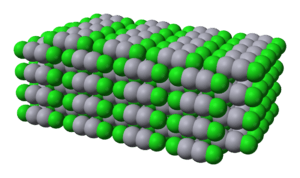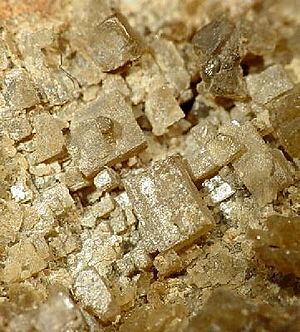Mercury(I) chloride facts for kids
Mercury(I) chloride is a special kind of chemical compound. You might also hear it called calomel or mercurous chloride. Its chemical formula is Hg2Cl2. This means it's made from two different parts: mercury and chlorides. The mercury in this compound has a +1 electric charge, which is called its oxidation state.
Contents
What is Calomel Like?
Calomel is usually a white or pale yellow solid. It looks like tiny crystals. This compound is poisonous, but it's not as dangerous as another mercury compound called mercury(II) chloride. This is because calomel does not dissolve easily in water.
Calomel can change back into pure mercury and mercury(II) chloride. This happens if it touches ammonia or if it's exposed to strong ultraviolet light. When it reacts with ammonia, it can turn black. The name "calomel" actually comes from Greek words meaning "beautiful black," because of this reaction! Calomel is also known as a weak reducing agent. It is the most common compound that contains mercury with a +1 charge.
Where is Calomel Found?
Sometimes, calomel can be found naturally as a mineral on Earth. However, it is quite rare to find it this way.
How is Calomel Made?
Scientists can make mercury(I) chloride in a lab. One way to make it is by mixing pure mercury with mercury(II) chloride. Another method is to react mercury(I) nitrate with something that contains chloride, like common sodium chloride.
What is Calomel Used For?
Calomel has a few important uses. In electrochemistry, it is used as a special tool called a reference electrode. These electrodes help scientists measure how easily other chemical substances can gain or lose electrons. This process is called oxidation and reduction.
Because calomel changes when light shines on it, it can be used to count how many tiny light particles, called photons, are in a light beam. In the past, calomel was even used as a medicine. However, it is no longer used for this purpose because it is known to be toxic.
Related Pages
See also
 In Spanish: Cloruro de mercurio(I) para niños
In Spanish: Cloruro de mercurio(I) para niños



